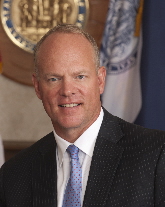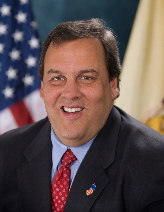Virginia’s ‘National Naysayer’ Streak Ends While New Jersey’s Continues
For the first time in 40 years Virginians elected a governor from the party of the sitting president; New Jersey extends its streak to seven cycles – second longest in the country

McAuliffe’s defeat of Republican Ken Cuccinelli ends Virginia’s nine-cycle streak of electing a governor from the opposing political party of the sitting president dating back to 1977.
Cuccinelli tried to rally his supporters in the waning days of the campaign by pronouncing they would “send a message to Washington” as he pounced on the Affordable Care Act’s implementation problems and controversial Obama administration statements on the ability of Americans to keep their health care plans.
Despite a bit of a surge in Cuccinelli’s favor, Virginians opted to vote Democratic on Tuesday, and with it ended the state’s streak as the ‘nation’s naysayer’ that began 36 years ago.
The last time Virginia elected a governor from the same party of the sitting president was 40 years ago in 1973 when GOPer Mills Goodwin edged out independent Henry Howell by 1.4 points with Richard Nixon in the White House.
Over the next nine cycles, Virginia did not follow the nation’s lead when it came to which party was going to run their state from the governor’s mansion:
· In 1977, one year after the election of Jimmy Carter, Republican John Nichols defeated Democrat and former Lieutenant Governor Henry Howell by 12.6 points.
· In 1981, after the election of Ronald Reagan, Democratic Lieutenant Governor Chuck Robb won the gubernatorial race with a 7.1-point victory over GOP Attorney General J. Marshall Coleman.
· In 1985, with Reagan winning a second term, Democrats held onto the governor’s seat with Attorney General Gerald Baliles beating Republican Wyatt Durrette by 10.4 points.
· In 1989, George H.W. Bush was inaugurated and Democrats won a third consecutive gubernatorial race with Lieutenant Governor Douglas Wilder narrowly beating 1981 GOP nominee J. Marshall Coleman by 0.4 points.
· In 1993, Clinton and the Democrats took back the White House and Republican congressman George Allen coasted to a 17.4-point victory over Democratic Attorney General Mary Sue Terry.
· In 1997, Clinton was reelected and Republicans held the governorship with Attorney General Jim Gilmore defeating Democratic Lieutenant Governor Don Beyer by 13.3 points.
· In 2001, George W. Bush took residence in the White House and Mark Warner won back the Executive Mansion for the Democrats by beating Republican Attorney General Mark Earley by 5.1 points.
· In 2005, Bush won a second term and Virginians elected Democratic Lieutenant Governor Tim Kaine by 5.7 points over Republican Attorney General Jerry Kilgore.
· In 2009, an Obama victory in the state the previous year could not help the party keep the governor’s seat with Republican Attorney General Bob McDonnell trouncing State Senator Creigh Deeds by 17.4 points.
With Virginia’s streak ending Tuesday, the new leader in the clubhouse as the nation’s naysayer is now Wyoming.

Wyoming opted for Democratic gubernatorial nominees in 1982 (Ed Herschler), 1986 (Michael Sullivan), 1990 (Sullivan), 2002 (Dave Freudenthal), and 2006 (Freudenthal) and Republicans in 1994 (Jim Geringer), 1998 (Geringer), and 2010 (Matthew Mead).
Wyoming is a shoo-in to expand their streak to nine cycles in 2014 with Governor Mead an overwhelming favorite to win reelection next November.
And as for New Jersey?

The last time New Jersey voters supported the party of the president in a gubernatorial race was in 1985 when Republican Thomas Kean was reelected to a second term in the middle of Ronald Reagan’s presidency.
Since then, Democrats Jim Florio (1989), Jim McGreevey (2001), and Jon Corzine (2005) won when Republicans ran the White House while Christine Todd Whitman (1993, 1997) and Christie (2009, 2013) were victorious with Democratic presidents in D.C.
In addition to New Jersey, Pennsylvania and Tennessee are also in the midst of seven straight cycles in which the president’s party has failed to win a gubernatorial race in their respective states (dating back to 1986 for each state).
Seven additional states have voted against the president’s party in a race for governor in at least five consecutive cycles: Kansas (since 1990), New Mexico (1990), Oklahoma (1990), and Wisconsin (1994) with six each and Arizona (1994), Maine (1994), and Michigan (1994) with five.
Gubernatorial Election Streaks Voting Against Party of Sitting President
|
Rank
|
State
|
Since |
# Cycles
|
|
1
|
Wyoming
|
1982
|
8
|
|
2
|
Pennsylvania
|
1986
|
7
|
|
2
|
Tennessee
|
1986
|
7
|
|
2
|
New Jersey
|
1989
|
7
|
|
5
|
Kansas
|
1990
|
6
|
|
5
|
New Mexico
|
1990
|
6
|
|
5
|
Oklahoma
|
1990
|
6
|
|
5
|
Wisconsin
|
1994
|
6
|
|
9
|
Arizona
|
1994
|
5
|
|
9
|
Maine
|
1994
|
5
|
|
9
|
Michigan
|
1994
|
5
|
|
12
|
Iowa
|
2002
|
3
|
|
12
|
North Carolina
|
2004
|
3
|
|
14
|
Ohio
|
2006
|
2
|
|
14
|
Utah
|
2010
|
2
|
|
16
|
Alaska
|
2006
|
1
|
|
16
|
Alabama
|
2010
|
1
|
|
16
|
Florida
|
2010
|
1
|
|
16
|
Georgia
|
2010
|
1
|
|
16
|
Idaho
|
2010
|
1
|
|
16
|
Nebraska
|
2010
|
1
|
|
16
|
Nevada
|
2010
|
1
|
|
16
|
Rhode Island*
|
2010
|
1
|
|
16
|
South Carolina
|
2010
|
1
|
|
16
|
South Dakota
|
2010
|
1
|
|
16
|
Texas
|
2010
|
1
|
|
16
|
Louisiana
|
2011
|
1
|
|
16
|
Mississippi
|
2011
|
1
|
|
16
|
Indiana
|
2012
|
1
|
|
16
|
North Dakota
|
2012
|
1
|
* Rhode Island Governor Lincoln Chafee was elected as an independent and later switched his affiliation to Democratic. Table compiled by Smart Politics.
And then there is the other end of the spectrum.
Which states have voted for the political party of the sitting president in gubernatorial elections for the longest stretch?
Vermont leads the way at 10 consecutive cycles, dating back to 1994.
The Green Mountain State elected Democrat Howard Dean while Bill Clinton was in office in 1994, 1996, 1998, and 2000, Republican Jim Douglas during George W. Bush’s presidency in 2002, 2004, 2006, and 2008, and Democrat Peter Welch during the first two cycles with Barack Obama in the White House.
Hawaii has voted the party of the president in gubernatorial elections in five consecutive cycles (also dating back to 1994), with only five other states with a current streak of more than one cycle: Connecticut (since 2002), Minnesota (2002), and California (2003) with three each and New Hampshire (2010) and West Virginia (2011) with two.
Gubernatorial Election Streaks Voting For Party of Sitting President
|
Rank
|
State
|
Since |
# Cycles
|
|
1
|
Vermont
|
1994
|
10
|
|
2
|
Hawaii
|
1994
|
5
|
|
3
|
Connecticut
|
2002
|
3
|
|
3
|
Minnesota
|
2002
|
3
|
|
3
|
California
|
2003
|
3
|
|
6
|
New Hampshire
|
2010
|
2
|
|
6
|
West Virginia
|
2011
|
2
|
|
8
|
Arkansas
|
2010
|
1
|
|
8
|
Colorado
|
2010
|
1
|
|
8
|
Illinois
|
2010
|
1
|
|
8
|
Maryland
|
2010
|
1
|
|
8
|
Massachusetts
|
2010
|
1
|
|
8
|
New York
|
2010
|
1
|
|
8
|
Oregon
|
2010
|
1
|
|
8
|
Kentucky
|
2011
|
1
|
|
8
|
Delaware
|
2012
|
1
|
|
8
|
Missouri
|
2012
|
1
|
|
8
|
Montana
|
2012
|
1
|
|
8
|
Washington
|
2012
|
1
|
|
8
|
Virginia
|
2013
|
1
|
Table compiled by Smart Politics.
Follow Smart Politics on Twitter.

With the “underwater/upsidedown” ratings of both outgoing governor and 170 plus-day president, NJ seems poised to continue The Streak this coming November. (Presuming his numbers remain mired no better than the high 30s) Will WY and TN elect a non-R in 11 of ’18?